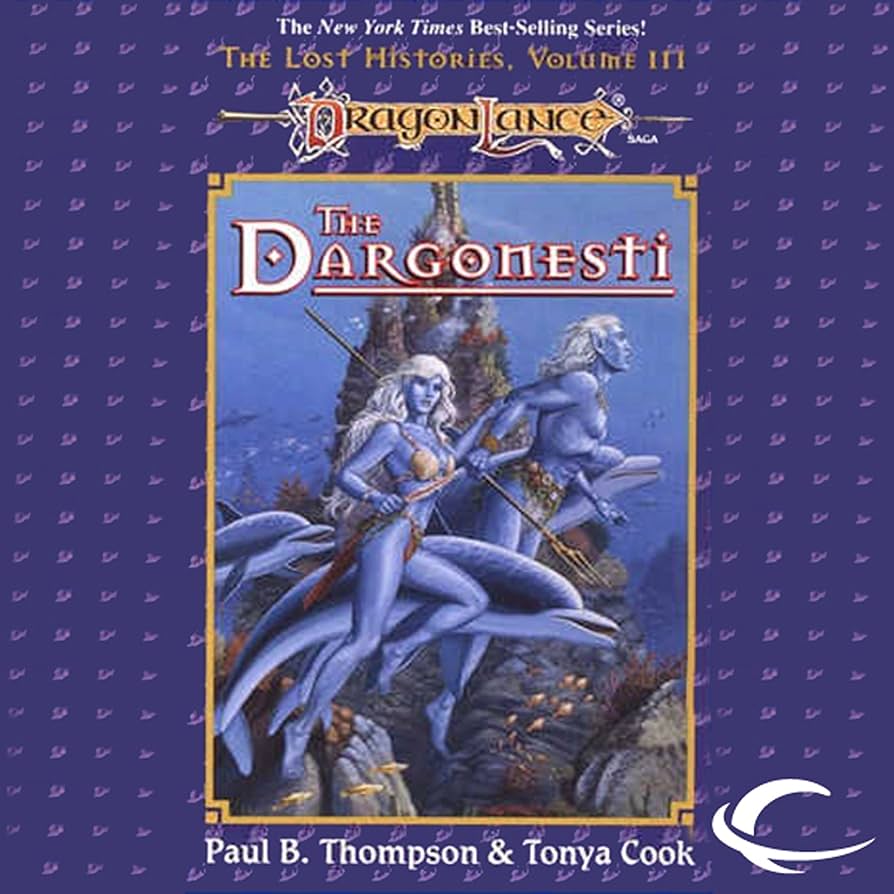The Dargonesti

Table of Contents
ToggleOverview
The Dargonesti takes readers far from the familiar shores of Ansalon to the oceanic realm of the Dargonesti sea elves—a secretive and mysterious race rarely explored in Dragonlance novels. The story follows Vixa, a fiery young noblewoman from Qualinesti, whose unexpected plunge into the sea pulls her into an alien world of beauty, danger, and manipulation.
This is a story of personal transformation, of encountering the “other,” and of what freedom really means—set against the backdrop of war, politics, and the deadly elegance of life beneath the surface.
Main Character: Vixa Ambrodel
- A young Qualinesti noblewoman, independent, proud, and unafraid of battle.
- When her ship is sunk during a naval expedition, Vixa is captured and taken to the undersea city of Urione, home of the Dargonesti elves.
- She becomes both a prisoner and a curiosity, as well as an eventual warrior and symbol of change.
- Her arc is one of identity, cultural awakening, and the painful realization that not all chains are made of iron.
Supporting Characters
- Naxos – A powerful and enigmatic Dargonesti prince. Charismatic but morally ambiguous, he sees Vixa as both threat and opportunity.
- Elendar – A fellow surface elf held captive, who offers Vixa emotional support and a foil to her fiery nature.
- Queen Uriona – The calculating ruler of the Dargonesti, whose grip on power is as cold as the ocean depths.
- The Dimernesti – A related aquatic elven race, often considered “sea nomads,” contrasting with the Dargonesti’s structured society.
Setting
- The majority of the novel is set in Urione, the majestic and mysterious capital of the Dargonesti, carved into coral, lit by glowing fish, and sustained by ancient magic.
- Life in Urione is beautiful but deeply authoritarian—an eerie underwater dystopia beneath a glittering surface.
- There are also flashbacks and surface-world moments in Qualinesti, helping contrast land-bound freedom with aquatic captivity.
Plot Summary
From Warrior to Captive
Vixa commands a Qualinesti ship in a military operation. When her ship is destroyed in an undersea attack, she is captured by the Dargonesti and taken to Urione. She survives only because of her willpower and curiosity, which intrigue her captors.
There, she discovers a rigidly ordered society of sea elves who can transform into dolphins, governed by tradition and hierarchy, where freedom is an illusion.
A Guest in a Gilded Cage
Though not placed in chains, Vixa is forbidden from leaving, kept under surveillance, and used as a symbol—a land elf brought “home” to the sea, whether she wants it or not.
She slowly gains respect, becoming a warrior among the Dargonesti. But as she sees how beauty masks control, she realizes her new role is no less limiting than captivity.
Vixa is also caught between romantic tension with Naxos and her own desire for independence, knowing that his world is not hers.
Rebellion and Revelation
As Vixa uncovers more of the sea elves’ politics and tensions between castes, she learns of a secret resistance—and of a dark pact that could doom both land and sea.
She joins a daring rebellion, fighting not just to escape, but to expose the truth about Urione, and to save others from the same fate.
The End and Transformation
In a final act of defiance, Vixa helps break the Dargonesti hold on their captives, and escapes back to the surface—but not unchanged.
She has become something more: a survivor of two worlds, with a new understanding of her place in Krynn—and the cost of freedom.
Themes
- Freedom vs. Captivity – Vixa is technically honored in Urione, but she’s still a prisoner. The novel explores how freedom is more than physical escape—it’s choice.
- Cultural Clash and Identity – A land elf learning to navigate sea elf customs becomes a metaphor for confronting the “other” without losing yourself.
- Beauty as Control – The Dargonesti world is breathtaking—but also rigid, cold, and subtly oppressive.
- Transformation and Self-Discovery – Vixa’s emotional, political, and physical journey reshapes her into a new kind of hero.
- Love and Power – The romantic tension between Vixa and Naxos raises questions about dominance, control, and trust in complex relationships.
Tone & Style
- Lyrical, immersive, and haunting, with vivid underwater imagery and melancholy undercurrents.
- Less action-heavy, more focused on internal conflict, cultural exploration, and symbolic storytelling.
- At times reads like a fantasy fairy tale or myth, with its own rhythm, rules, and symbolism.
- Includes sensuality, sorrow, and subversion, giving it a more mature and introspective tone than many Dragonlance novels.
Reception
The Dargonesti is praised for:
- Being unlike any other Dragonlance novel, in tone and setting.
- Deep worldbuilding of an aquatic culture and magic system.
- A strong and complex female lead in Vixa.
- Boldly tackling themes of captivity, cultural identity, and psychological freedom.
Some critiques include:
- Slower pace and less traditional fantasy action.
- The ending is ambiguous and emotionally heavy, not a clean triumph.
Still, it’s often considered a hidden gem, especially for fans of underwater worlds, introspective storytelling, and morally gray fantasy.
Final Thoughts
The Dargonesti is a haunting, beautifully written tale of freedom, love, and defiance, told from a perspective rarely seen in Krynn. It shines a light into the darkest depths of the sea—and of the soul—showing how even paradise can become a prison.
Recommended for:
- Fans of underwater fantasy, mythic storytelling, and emotional character journeys
- Readers interested in the lesser-known races of Krynn
- Anyone who loves a story that asks hard questions about culture, freedom, and belonging
“In the sea, nothing is truly still. Even silence moves.”
